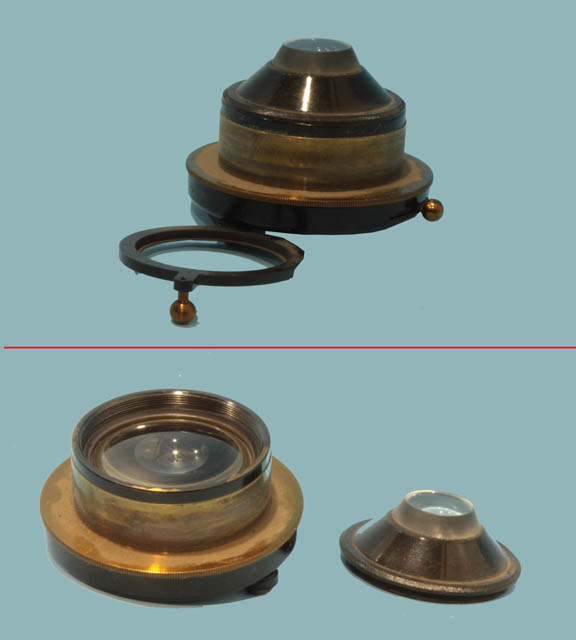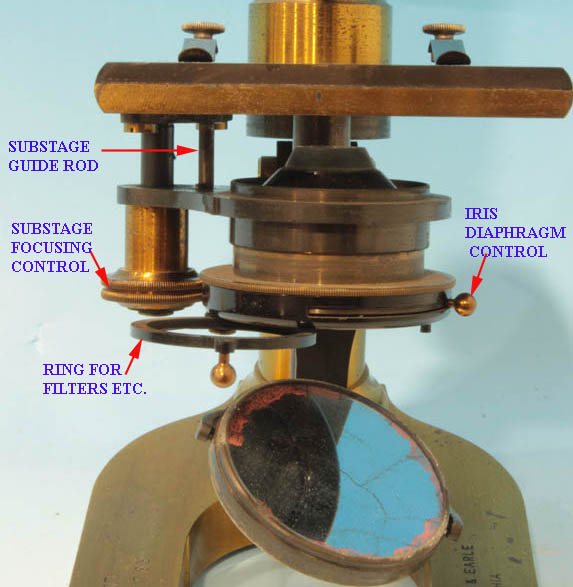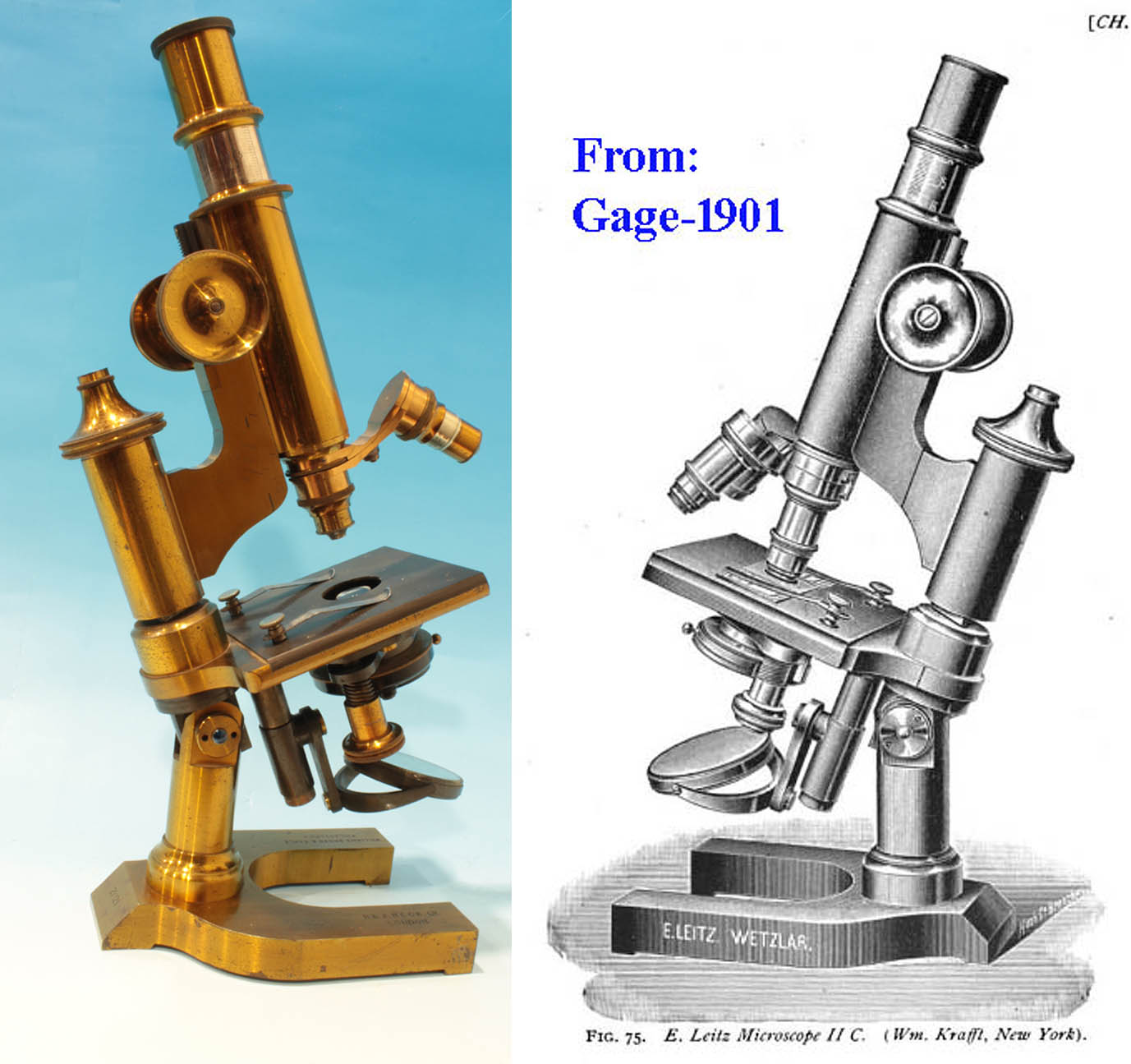COMPOUND CONTINENTAL MICROSCOPE
MAKER: R & J BECK
MODEL: No. 29a IMPROVED CONTINENTAL
MICROSCOPE-With Substage
SERIAL NUMBER: 21121
c. 1896
SIGNED ON RIGHT SIDE OF FOOT: R & J BECK LTD, LONDON
SIGNED ON LEFT SIDE OF FOOT: WILLIAMS BROWNE & EARLE, PHILADELPHIA
Please Click On Any Picture for a Larger Version
DESCRIPTION:
This is a monocular continental-type compound microscope from the late 19th Century. It was made in England by R. & J. Beck for retail sale in America by their agents Williams, Browne, and Earle of Philadelphia PA. It has a horseshoe foot with a slanted back bearing the serial number of 21121. From the foot, a short pillar leads to the inclination joint. The stage is covered with hard rubber and has two nickel plated steel stage clips. Coarse focus is by diagonal rack and pinion and fine focus is by continental screw acting on the limb. The knurled knob controlling fine focus tapers to a small diameter at the top where it is also knurled, providing a way to more rapidly adjust the fine focus than with the larger diameter part at its bottom-a form of two speed
fine focus. The nickel-plated draw tube is calibrated from 14 to 20 cm marked every mm and labeled every cm. The tube accepts the continental standard 22 mm diameter eyepiece, of which two are supplied, including one marked 1
and another marked 3
. The double nose piece carries a brass and nickel finished R & J Beck Ltd A
objective labeled with a 6 mm focal length. The other R & J Beck Ltd objective is also labeled as an A
and is its focal length is labeled as 2/3
and 14 mm
. The tailpiece supporting the gimbaled mirror descends from the bottom of the stage. The mirror gimbal is attached to a vertically-oriented bar which is hinged at its top end to a round tube that can slide up or down or swivel on the tail piece.


The Abbe-type condenser, slides into the substage focusable ring. It has an iris diaphragm below the optical parts, and below that a swing-out ring to hold filters or oblique illumination stops. The top element of the condenser can be unscrewed and removed so the bottom element below can be used for low power work (see illustration to the left). The condenser assembly is focused up or down via a vertically-oriented brass knob acting on the coarse threads of the condenser adjusting screw. The assembly is guided up and down on a steel pin descending from the stage; when the condenser holder is brought all the way down, it passes the end of the rod and the entire condenser assembly can be swung out of the optical axis.
The microscope came in its original fitted case with lock and key.
HISTORY:

James Smith founded this firm and signed his microscopes starting in 1839. He took in Richard Beck, nephew of J.J. Lister, as his partner in 1847 when the firm became Smith & Beck. In 1851, Joseph Beck joined, and, in 1857 the company became Smith, Beck, and Beck. Smith retired in 1865 and the firm became R & J Beck. It became R & J Beck Ltd in 1894, dating the microscope featured on this page to that year or later. Extrapolation of known serial number dates places it about 1896 or 1897. Interestingly, as shown to the left, it is virtually identical to the Leitz IIc model as pictured in the 1901 edition of Gage's book The Microscope except for the fact that the control for the focusing of the condenser is on the opposite side. The serial number of this microscope, dating to the late 1890s is close to the date of Gage's book. At the time this microscope was made, Williams, Browne and Earle had become the sole distributors for Beck in the U.S.A.
It is the general consensus that most of the major English makers, including Beck, started to copy the Continental designs in the 1880s and most of the major English makers offered continental style microscopes by the 1890s. The Beck Catalog of 1882 includes the Economic
model, with a continental limb but a flat tripod foot, but it was not until later that Beck produced microscopes they specifically called "Continental". These, like the example on this page, and as shown to the left, very closely resembled the German continental microscopes of the day, including their horseshoe
type of foot, Abbe-type condenser and screw focusing substage.
CONDITION:
This microscope is in very fine condition. All features work as they should and the optics are all clean and clear. There are a few scratches on the main optical tube and limb and minor losses to the lacquer elsewhere. The stage clips have some corrosion. The mirrors have lost some of their silver but are unbroken.


